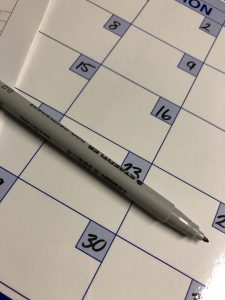How to Set Yourself Up for Success This Semester
I’m a big believer in preparing for things in a way that act as a launch pad and build towards what I want to accomplish.
Each new academic term I like to push myself to be better than the last time (Charles recently made a great post on critical reflection in regards to this that I highly recommend), but my pre-term preparations are mainstays for me now.
In honour of the new academic term, here are nine steps I take to set myself up for a great term:
1. Clean your space
The next steps will be way easier if you first take the time to tidy. Personally, I struggle to concentrate if there’s clutter.
This is also a good chance to organize or find something you forgot you had lying around. Organization will be key for tip #5.
2. Make a to-do list

Photo by Priscilla Du Preez via Unsplash
Regardless whether you have a good memory or not a list can help you prioritize, visualize what is happening, and make a plan.
For example, complete all of your errands in one trip if possible, or printing anything you need all at once.
3. Read your syllabi
Syllabi and any other course business documents your instructors give you will tell you almost anything you could need to know about the course you’re taking.
Make a list of any software, textbooks, or other supplies you may need so you can budget accordingly. Like I said in the previous step, this helps you get an overall picture of what you need going into the new term.
4. Figure out your textbook situation

My textbooks from first year
For this I like to consult the Bookstore’s booklist as well as the syllabus which sometimes mention optional materials that can be purchased at your own discretion.
Once you know what you need some students will purchase right away (I do this so I can start reading the first chapters outlined in the syllabus during the first week of classes) or wait until you’ve gone to the first class.
I wrote another post last year on different textbook formats and some methods students use when book buying here.
5. Assess what you have
Chances are you’ve accumulated a lot of supplies over the years, and now’s the time to assess what to do with all of it.
For example, you may have most of the stationery items you like to have on hand for note-taking and completing coursework but need binders to house a loose-leaf textbook.
Focusing in on what your pertinent needs are will keep you from splurging on whatever catches your eye and keep your spending within your budget.
This is also a time to make sure any accounts you use for school are working and that the devices you use are running well. I like to check for updates a few days before classes to get any updates and have time to fix them if anything were to go wrong.
Also if you like to print schedule templates or weekly layouts of your courses this is a great time to do it.
6. Build calendars and weekly layouts
I’d like to preface this by saying use whatever works for you, after all you’re the one who’ll have to use it. Whether it’s a dry erase calendar, bullet journal, Google calendar, paper planner, sticky-note on a wall resembling a calendar, or something else.
Take the time to create what you need. I like to make a general weekly timetable with just my course related lectures, labs, and tutorials. This timetable is stuck up by my desk before my first class of the term since it usually takes me a week or two to commit my new schedule to memory.
7. Populate whatever you use for planning

My tool of choice for keeping track of deadlines and visualizing the weeks ahead is a four month dry-erase calendar – Photo by Me
Add due dates and important dates supplied by UVic to your calendar so you can find your deadlines in one place.
I like to use a four month dry erase calendar (which I talk about here) and a paper planner which serves as more of a running prioritized to-do list that gives me a snapshot of what I want to accomplish in a certain day (like getting an assignment done early).
Use your syllabi to make sure you haven’t missed anything. Don’t forget to include minor deadlines such as signing up for group project topics since these tend to be forgotten.
8. Update software and troubleshoot anything that isn’t working at 100%
Echoing what I said above, make sure everything is in top shape. I like to check Zoom and Microsoft 360 for updates since I use them most frequently.
Troubleshooting can usually be an easy fix since chances are the service or device you’re using has a guide already available online for it.
The UVic Help Desk is a great resource for when you can’t resolve the problem on your own or if you need help with something. I recommend saving their info in a few places just in case.
9. Plan out your life outside of academics
Chances are you’ll have to plan out your participation in clubs, spending time with friends, and other aspects of your life around your course schedule.
Take an hour to figure out where you can fit all of these parts of your life in a way that won’t leave you burnt out and exhausted a few weeks into term.
This part of planning can be difficult, but it’s important to be realistic with how much you can fit into a day both time-wise and emotionally.
Make sure you leave “time-cushions” in case something runs late or takes longer than expected, and make sure you have adequate time to take a break, sleep, and eat. Keeping your full schedule realistic can set you up for success both in the short and long term.
Do you have any pre-term prep rituals I didn’t mention here? Leave a comment below!



